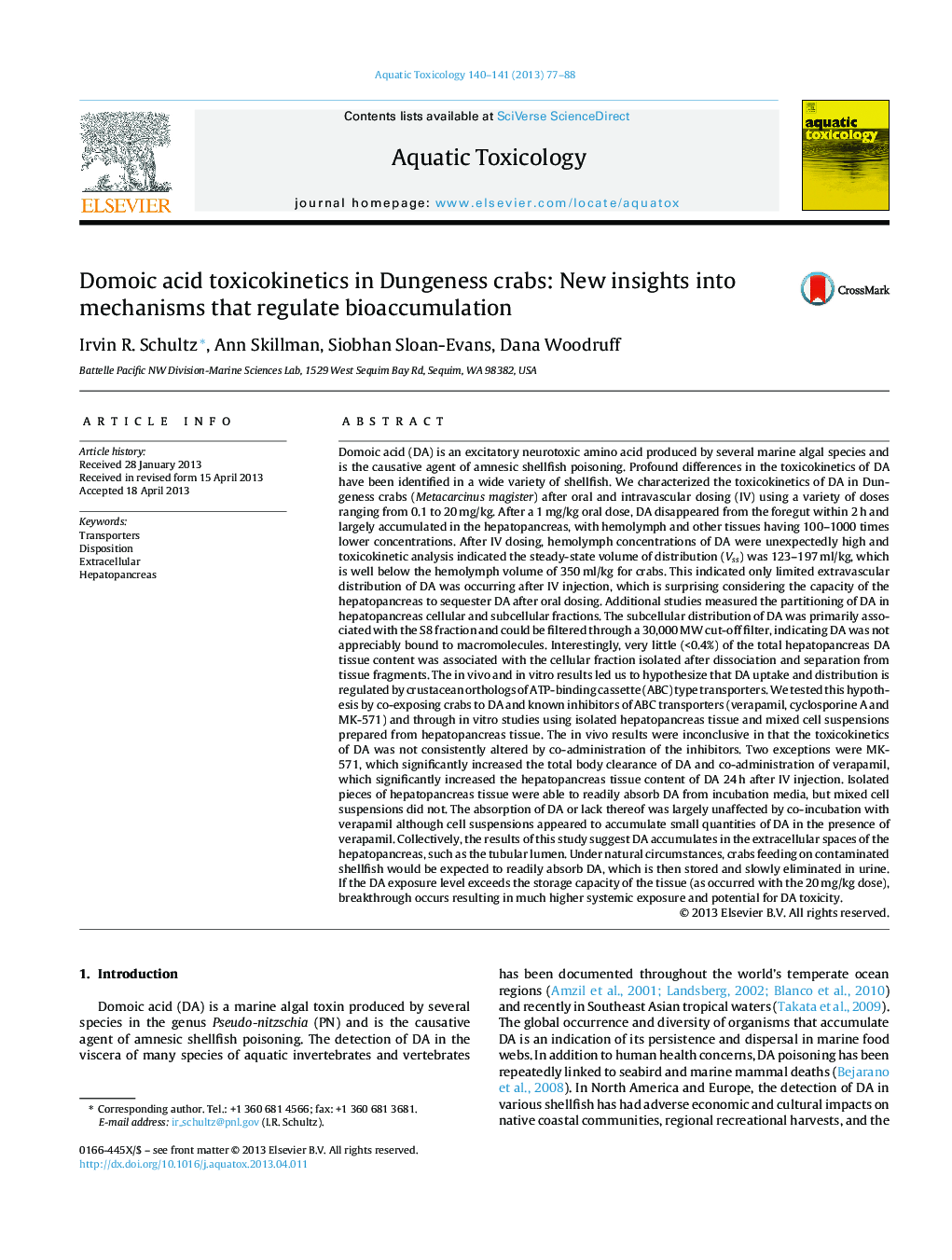| کد مقاله | کد نشریه | سال انتشار | مقاله انگلیسی | نسخه تمام متن |
|---|---|---|---|---|
| 6382489 | 1625962 | 2013 | 12 صفحه PDF | دانلود رایگان |
عنوان انگلیسی مقاله ISI
Domoic acid toxicokinetics in Dungeness crabs: New insights into mechanisms that regulate bioaccumulation
دانلود مقاله + سفارش ترجمه
دانلود مقاله ISI انگلیسی
رایگان برای ایرانیان
کلمات کلیدی
موضوعات مرتبط
علوم زیستی و بیوفناوری
علوم کشاورزی و بیولوژیک
علوم آبزیان
پیش نمایش صفحه اول مقاله

چکیده انگلیسی
Domoic acid (DA) is an excitatory neurotoxic amino acid produced by several marine algal species and is the causative agent of amnesic shellfish poisoning. Profound differences in the toxicokinetics of DA have been identified in a wide variety of shellfish. We characterized the toxicokinetics of DA in Dungeness crabs (Metacarcinus magister) after oral and intravascular dosing (IV) using a variety of doses ranging from 0.1 to 20Â mg/kg. After a 1Â mg/kg oral dose, DA disappeared from the foregut within 2Â h and largely accumulated in the hepatopancreas, with hemolymph and other tissues having 100-1000 times lower concentrations. After IV dosing, hemolymph concentrations of DA were unexpectedly high and toxicokinetic analysis indicated the steady-state volume of distribution (Vss) was 123-197Â ml/kg, which is well below the hemolymph volume of 350Â ml/kg for crabs. This indicated only limited extravascular distribution of DA was occurring after IV injection, which is surprising considering the capacity of the hepatopancreas to sequester DA after oral dosing. Additional studies measured the partitioning of DA in hepatopancreas cellular and subcellular fractions. The subcellular distribution of DA was primarily associated with the S8 fraction and could be filtered through a 30,000Â MW cut-off filter, indicating DA was not appreciably bound to macromolecules. Interestingly, very little (<0.4%) of the total hepatopancreas DA tissue content was associated with the cellular fraction isolated after dissociation and separation from tissue fragments. The in vivo and in vitro results led us to hypothesize that DA uptake and distribution is regulated by crustacean orthologs of ATP-binding cassette (ABC) type transporters. We tested this hypothesis by co-exposing crabs to DA and known inhibitors of ABC transporters (verapamil, cyclosporine A and MK-571) and through in vitro studies using isolated hepatopancreas tissue and mixed cell suspensions prepared from hepatopancreas tissue. The in vivo results were inconclusive in that the toxicokinetics of DA was not consistently altered by co-administration of the inhibitors. Two exceptions were MK-571, which significantly increased the total body clearance of DA and co-administration of verapamil, which significantly increased the hepatopancreas tissue content of DA 24Â h after IV injection. Isolated pieces of hepatopancreas tissue were able to readily absorb DA from incubation media, but mixed cell suspensions did not. The absorption of DA or lack thereof was largely unaffected by co-incubation with verapamil although cell suspensions appeared to accumulate small quantities of DA in the presence of verapamil. Collectively, the results of this study suggest DA accumulates in the extracellular spaces of the hepatopancreas, such as the tubular lumen. Under natural circumstances, crabs feeding on contaminated shellfish would be expected to readily absorb DA, which is then stored and slowly eliminated in urine. If the DA exposure level exceeds the storage capacity of the tissue (as occurred with the 20Â mg/kg dose), breakthrough occurs resulting in much higher systemic exposure and potential for DA toxicity.
ناشر
Database: Elsevier - ScienceDirect (ساینس دایرکت)
Journal: Aquatic Toxicology - Volumes 140â141, 15 September 2013, Pages 77-88
Journal: Aquatic Toxicology - Volumes 140â141, 15 September 2013, Pages 77-88
نویسندگان
Irvin R. Schultz, Ann Skillman, Siobhan Sloan-Evans, Dana Woodruff,